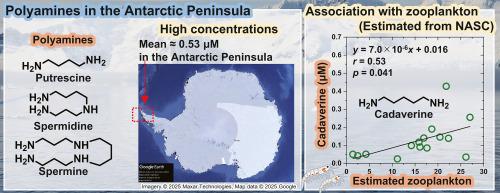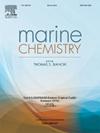多胺是南极半岛主要的有机碱性化合物
IF 2.5
3区 地球科学
Q2 CHEMISTRY, MULTIDISCIPLINARY
引用次数: 0
摘要
多胺,如腐胺、亚精胺和精胺,作为营养物质和生物活性化合物对海洋微生物至关重要。虽然在不同的海洋区域对它们的存在进行了研究,但它们在南极地区仍未得到研究,而且没有研究将多胺与单胺(另一类有机氮化合物)进行比较。本研究采用4-(N,N-二甲氨基磺酰基)-7-氟-2,1,3-苯并恶二唑(DBD-F)衍生化和HPLC-MS/MS技术对南极半岛西部地区海水中的多胺和单胺进行了定量分析。在南极首次检测到亚μM ~ μM水平的多胺,比低纬度地区报道的多胺含量高约2个数量级。虽然总多胺浓度在五个采样点之间没有显着差异,但在不同的地点之间观察到不同的多胺组成模式。在Wilhelmina Bay,总多胺与浮游动物反向散射(NASC)呈显著正相关(r = 0.53, n = 15, p = 0.04)。我们的结果建立了南极多胺的基线,并揭示了海湾间物种组成的差异。这些基线观测为跟踪多胺动力学如何响应南大洋环境变化奠定了基础。本文章由计算机程序翻译,如有差异,请以英文原文为准。

Polyamines as predominant organic basic compounds in the Antarctic Peninsula
Polyamines, such as putrescine, spermidine, and spermine, are vital for marine microorganisms as nutrients and bioactive compounds. While their presence has been studied in various marine regions, they remain unexamined in the Antarctic region, and no study has compared polyamines with monoamines, another class of organic nitrogen compounds. This study quantified polyamines and monoamines in seawater in the West Antarctic Peninsula region using 4-(N,N-dimethylaminosulfonyl)-7-fluoro-2,1,3-benzoxadiazole (DBD-F) derivatization and HPLC-MS/MS. Polyamines were detected in Antarctica for the first time at sub-μM to μM levels, and it was approximately two orders of magnitude higher than reports from lower-latitude regions. Although total polyamine concentrations did not differ significantly among the five sites sampled, distinct patterns in polyamine composition were observed between the sites. In Wilhelmina Bay, total polyamines exhibited a positive but non-significant association with zooplankton backscatter (NASC), while cadaverine alone correlated significantly (r = 0.53, n = 15, p = 0.04). Our results established a baseline for Antarctic polyamines and revealed bay-to-bay differences in species composition. These baseline observations set the stage for tracking how polyamine dynamics respond to environmental change in the Southern Ocean.
求助全文
通过发布文献求助,成功后即可免费获取论文全文。
去求助
来源期刊

Marine Chemistry
化学-海洋学
CiteScore
6.00
自引率
3.30%
发文量
70
审稿时长
4.5 months
期刊介绍:
Marine Chemistry is an international medium for the publication of original studies and occasional reviews in the field of chemistry in the marine environment, with emphasis on the dynamic approach. The journal endeavours to cover all aspects, from chemical processes to theoretical and experimental work, and, by providing a central channel of communication, to speed the flow of information in this relatively new and rapidly expanding discipline.
 求助内容:
求助内容: 应助结果提醒方式:
应助结果提醒方式:


